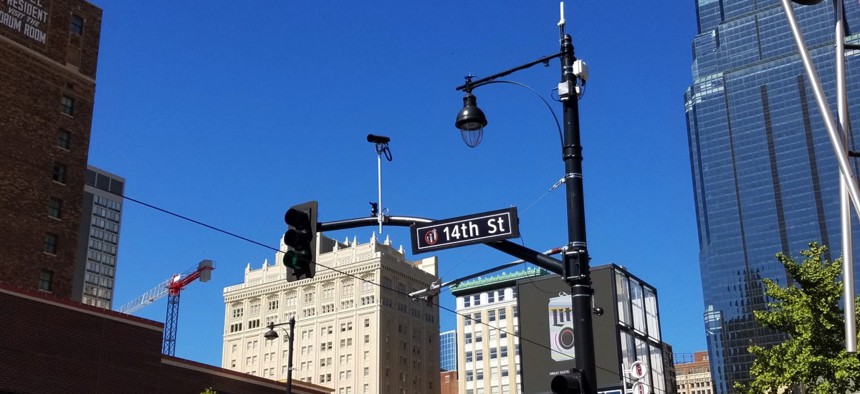Remember the Human Element When Implementing Smart City Technologies

Sensors and other smart infrastructure line the Main Street corridor in downtown Kansas City's Power and Light District. Michael Grass / Route Fifty
Building sensor networks seems like the most difficult step, but that’s just the start on the long road to a smarter local government.
KANSAS CITY, Mo. — With Missouri’s largest municipality hosting the International City / County Management Association’s 102nd annual conference this week, it’s a great opportunity for the City of Fountains to show off its smart city credentials. And there’s plenty to see just steps from the convention center.
The Main Street corridor forms the downtown area’s north-south spine and connects the River Market area with Kansas City’s commercial core, the Power and Light District entertainment area and Union Station. Main Street is the centerpiece for Kansas City’s smart infrastructure, which took shape as a streetcar line and updated streetscape where built.
Sensor networks atop streetlights and other utility infrastructure can estimate the number of pedestrians on sidewalks and the level of traffic in the street. That can allow for street lights to dim when there isn’t anyone on the sidewalk, which conserves energy and money, plus adjust traffic signal cycles to better manage vehicle flow and allow the streetcar to move seamlessly along the corridor. Those networks, along with the fiber in the ground, also lay the foundation for the development of new applications for the city and the general public down the road.

While these technologies aren’t necessarily new to urban landscapes, many U.S. local governments are still grappling with what it means to be smart city, what it takes to implement advanced digital infrastructure and how to finance those investments. Many municipalities are looking to places like Kansas City and other leaders in the smart city movement to figure out how to best proceed.
But there’s an important point to remember when implementing smart city technology: “Simply plugging in a sensor and declaring yourself a smart city is just the start.”
That’s according to Eric Roche, Kansas City’s chief data officer, who was part of a panel discussion on smart city technologies on Monday afternoon.
The critical next steps, he said, involve how to effectively connect the advanced systems and the valuable data delivered through those systems with the municipal workforce that needs to manage them.
While consultants and third-party vendors can provide valuable resources and expertise for municipal governments when it comes to smart city technologies, “we have to have the ability to … understand what these systems are telling us,” Roche said. “How does it connect back to staff who have to make sense of it?”
Bringing “public policy out of algorithms” is easier said than done.
Roche said that when a local government has smart city ambitions, it oftens hires somebody with expertise to sit in the mayor’s office—someone with centralized authority to develop and implement a plan across municipal agencies. But there’s a workforce problem with that approach.
“I’m concerned about what happens when that person leaves,” he said.
That smart city expertise needs to be embraced throughout government and beyond the braintrust that championed the advanced technology. The data that is delivered through the smart infrastructure needs to be integrated into everyday operations.
And if all that is effectively baked into the municipal cake, when that key smart city champion leaves, the city isn’t left with a lot of advanced—and expensive—technology that stagnates.
An integrated workforce approach with smart cities ensures really smart investments both in technology and the people who turn the gears of local government.
PREVIOUSLY on Route Fifty:
Michael Grass is Executive Editor of Government Executive’s Route Fifty and is based in Seattle.
NEXT STORY: Examining California's Pension Gap






